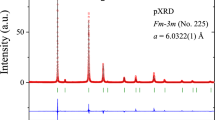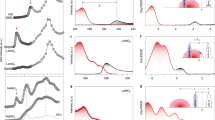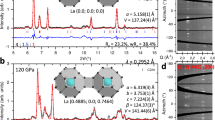Abstract
SUPERCONDUCTING intermetallic compounds with relatively high transition temperature (Tc) have been found in the systems Ln–Tr–B–C, where Ln is a lanthanide element (Y, Ho–Lu) and Tr a transition metal (Pd or Ni)1,2. In the nickel-bearing system, the superconducting phase has the formula LnNi2B2C (ref. 2). Although many structures are known for ternary carbides and borides, only a few have been reported for quaternary boro-carbides3. Here we describe two new phases that form in the Lu–Ni–B–C system: LuNi2B2C, a superconductor with a Tc of 16.6 K (ref. 2), and LuNiBC, a closely related non-superconducting phase. The superconductor is a variant on the layered ThCr2Si2-type structure4, with additional carbon in the Lu plane. LuNiBC is derived from LuNi2B2C by adding another layer of Lu–C, producing a NaCl-type intergrowth. A new homologous series of inter-metallic phases may be derivable from the simple building principles of these two structures.
This is a preview of subscription content, access via your institution
Access options
Subscribe to this journal
Receive 51 print issues and online access
$199.00 per year
only $3.90 per issue
Buy this article
- Purchase on Springer Link
- Instant access to full article PDF
Prices may be subject to local taxes which are calculated during checkout
Similar content being viewed by others
References
Cava, R. J. et al. Nature 367, 146–148 (1994).
Cava, R. J. et al. Nature 367, 252–253 (1994).
Villars, P. & Calvert, L. D. Pearson's Handbook of Crystallographic Data for Intermetallic Phases Vols 1–4 (ASM International, Materials Park, 1991).
Parthé, E. & Chabot, B. in Handbook on the Physics and Chemistry of Rare Earths Vol. 6 Ch. 48 (eds Gschneidner, K. A. & Eyring, L.) 113–334 (North-Holland, Amsterdam, 1984).
LePage, Y., White, P. S. & Gabe, E. J. Poster PA23 presented at Am. crystallogr. Assoc. a. Meet., Hamilton, Canada (AIP, New York, 1986).
Gabe, E. J., LePage, Y., Charland, J.-P., Lee, F. L. & White, P. S. J. appl. Crystallogr. 22, 348–387 (1989).
Buschow, K. H. J. in Handbook on the Physics and Chemistry of Rare Earths Vol. 6 Ch. 47 (eds Gschneidner, K. A. & Eyring, L.) 1–111 (North-Holland, Amsterdam, 1984).
Shannon, R. D. & Prewitt, C. T. Acta crystallogr. B26, 1046–1048 (1970).
landelli, A. & Palenzona, A. in Handbook on the Physics and Chemistry of Rare Earths Vol. 2 Ch. 13 (eds Gschneidner, K. A. & Eyring, L.) 1–53 (North-Holland, Amsterdam, 1984).
Zandbergen, H. W. et al. Nature 332, 620–623 (1988).
Szytula, A. & Leciejewicz, J. in Handbook on the Physics and Chemistry of Rare Earths Vol. 12 Ch. 83 (eds Gschneidner, K. A. & Eyring, L.) 133–211 (North-Holland, Amsterdam, 1989).
Author information
Authors and Affiliations
Rights and permissions
About this article
Cite this article
Siegrist, T., Zandbergen, H., Cava, R. et al. The crystal structure of superconducting LuNi2B2C and the related phase LuNiBC. Nature 367, 254–256 (1994). https://doi.org/10.1038/367254a0
Received:
Accepted:
Issue Date:
DOI: https://doi.org/10.1038/367254a0
This article is cited by
-
Improved Analysis of Rare Earth Magnetic Superconductors
Journal of Superconductivity and Novel Magnetism (2021)
-
Simple analytical model of the effect of high pressure on the critical temperature and other thermodynamic properties of superconductors
Scientific Reports (2018)
-
Evolution of magnetic structure of Dy(CoxNi1−x)2B2C
Journal of Materials Science: Materials in Electronics (2018)
Comments
By submitting a comment you agree to abide by our Terms and Community Guidelines. If you find something abusive or that does not comply with our terms or guidelines please flag it as inappropriate.



